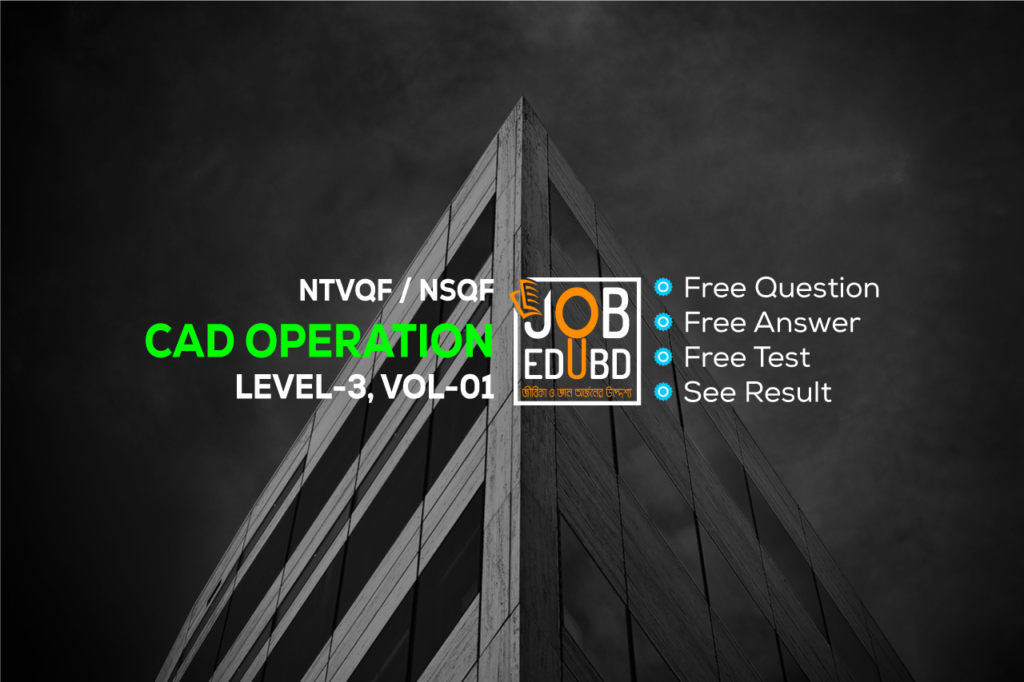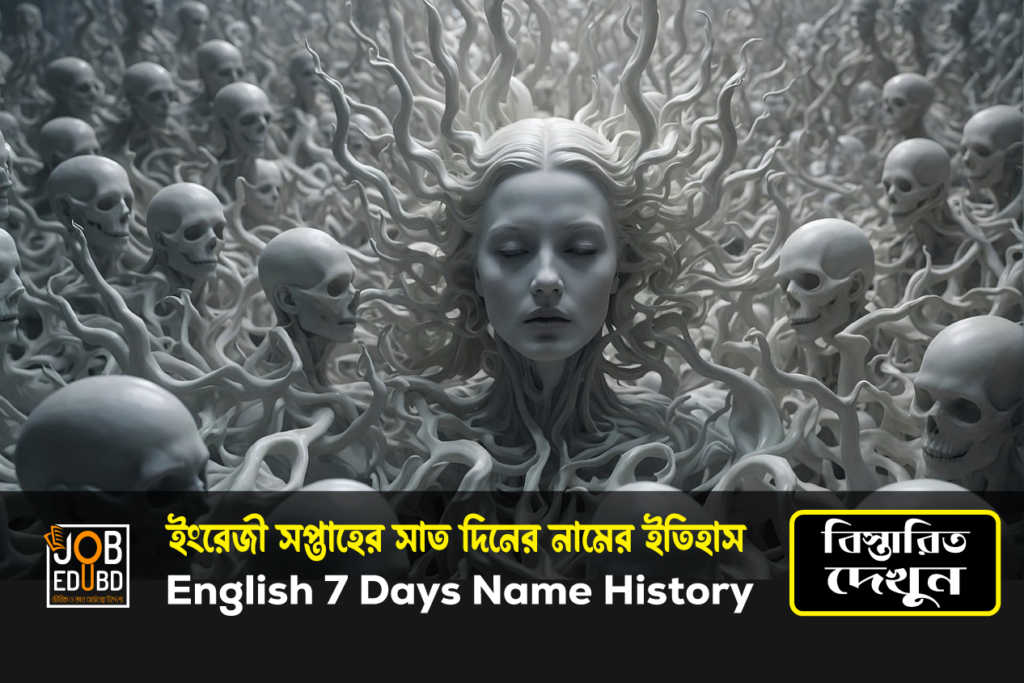Graphic Design Level-3 Suggestion V-8
Written Test Graphic Design Level-3 Suggestion V-8 by Job Edu BD
First, test yourself with the following MCQs, if you can’t do it, you can check the answer by clicking on the answer button.
Graphic Design level-3 Suggestion V-8
01. The two overlapping boxes at the bottom of the Adobe Illustrator toolbox control
- Texture and Gamma
- Stroke and shadow
- History and undo
- Fill and stroke
02. What does object expand do in illustrator?
- Divide a single object too many
- Group multiple object into single
- Convert multiple objects into one
- Merge all color in an object
03. Which of the following tool will cut a path into two different paths?
- Knife tool
- Scissors tool
- Pathfinder tool
- Bisect tool
04. Registration mark used for?
- Color Align
- Cutting
- Text Alignment
- Creating
05. Curve option used for
- Bright correction
- Contrast correction
- Hue correction
- Light correction
06. Which tool create vector in Photoshop?
- Shape tool
- Magic wand
- Pen tool
- Slice tool
07. Which image format is faster for internet upload/download?
- JPEG
- PNG
- TIFF
- GIF
08. The ruler bar is not used for
- Setting Margin
- Setting Guide
- Resize
- Book Design
09. The zoom tool is used for objects
- Magnifying
- Cropping
- Marquee
- Embedding
10. Shortcut to transform an object is
- Alt+T
- Ctrl+T
- Alt+N
- Crtl+L
11. “Space” is element of
- Visual element
- Design Principle
- Color Mode
- Color Theory
12. “Green” is a____color
- Secondary
- Primary
- Tertiary
- Tint
13. The two kinds of main memory are:
- Primary and secondary
- ROM and RAM
- Random and sequential
- All of the above
14. Which is not the function of the Operating System?
- Memory Management
- Disk Management
- Application Management
- Virus Protection
15. The standard aspect ratio for PC is
- 6:5
- 4:3
- 3:2
- 5:3
16. Which includes competency?
- Knowledge, Attitude, Job
- Knowledge, Skill, Attitude
- Skill, Attitude, Strategy
- Skill, Learning, Writing
17. What is called NTVQF level 2?
- Semi-Skilled Worker
- Basic Skilled Worker
- Skilled Worker
- Basic Worker
18. What is the role of Team Leader?
- Working with a team
- Working individual
- Guide a team
- Lead a tem
19. Which is underpinning skill?
- Thinking Positively
- Communication skill
- Managing Stress
- OSH management
20. Verbal Communication is
- Interpersonal Communication
- Underpinning Skill
- Underpinning knowledge
- Communication skill
21. “Graphics” Design or “Graphic” Design?
22. What is Graphic Design?
23. Who is Graphic Designer?
24. Principles of Graphic Design
25. Elements of Graphic Design
26. Applications of Graphic Design
27. Software Programs for Graphic Design
28. Warm colors are-
29. Cool Colors are-
30. To cut down the size of the entire graphic design, including all layers, you should select the …… tool.
01. The two overlapping boxes at the bottom of the Adobe Illustrator toolbox control
D. Fill and stroke
02. What does object expand do in illustrator?
A. Divide a single object too many
03. Which of the following tool will cut a path into two different paths?
B. Scissors tool
04. Registration mark used for?
A. Color Align
05. Curve option used for
B. Contrast correction
06. Which tool create vector in Photoshop?
A. Shape tool
07. Which image format is faster for internet upload/download?
B. PNG
08. The ruler bar is not used for
C. Resize
09. The zoom tool is used for objects
A. Magnifying
10. Shortcut to transform an object is
B. Ctrl+T
11. “Space” is element of
A. Visual element
12. “Green” is a____color
A. Secondary
13. The two kinds of main memory are:
B. ROM and RAM
14. Which is not the function of the Operating System?
B. Disk Management
15. The standard aspect ratio for PC is
B. 4:3
16. Which includes competency?
B. Knowledge, Skill, Attitude
17. What is called NTVQF level 2?
B. Basic Skilled Worker
18. What is the role of Team Leader?
A. Working with a team
C. Guide a team
D. Lead a team
19. Which is underpinning skill?
B. Communication skill
20. Verbal Communication is
A. Interpersonal Communication
21. “Graphics” Design or “Graphic” Design?
What we see on our computer screen is a sequence of images, not just a static image so at this the term “Graphic” is used as plural form as “Graphics” which refers to a computer-generated image.
“Graphic” Design is the use of graphics, typography, graphs, and images to communicate an idea through design.
22. What is Graphic Design?
Graphic design is a craft where professionals create visual content to communicate messages by applying visual hierarchy and page layout techniques, typography and images to meet users’ specific needs and focus on the logic of displaying elements in interactive designs, to optimize the user experience.
23. Who is Graphic Designer?
Graphic designers are those who does plan, analyze, and create visual solutions to communications problems. They decide the most effective way of getting a message across in print, electronic or film media.
24. Principles of Graphic Design
Contrast
Balance
Emphasis
Movement
White Space
Proportion
Hierarchy
Repetition
Rhythm
Pattern
Unity
Variety
25. Elements of Graphic Design
Line
Shape
Color
Texture
Type
Space
Image
Conclusion
26. Applications of Graphic Design
Logo
Icon
Album covers
Film and television titles and graphics
T-shirt and clothing designs
Greeting cards
Website Design
Animated Graphics
Signage
Corporate identity/branding
Packaging (from water bottles to appliances)
Printed materials (books, flyers, magazines, newspapers)
Online art (banners, blogs, websites)
27. Software Programs for Graphic Design
Adobe Photoshop, Adobe Illustrator, Adobe InDesign, Adobe XD, Maya, Coral Draw
28. Warm colors are-
Red, Orange, Yellow
29. Cool Colors are-
Blue, Green, Purple
30. To cut down the size of the entire graphic design, including all layers, you should select the …… tool.
Crop.

MD. SALAHUDDIN
CSE, BUBT
In-Charge (Graphic Design)
Instructor
Bangladesh-German Technical Training Center
Mirpur-2, Dhaka-1216
Graphic Design Level-3 Suggestion V-3
"You will pass just by asking the mentioned questions, it's not like that at all, but chances are upto 80% to get common. This is just a suggestion. This question is not copied from any board question"
Related Post
Graphic design is a profession,[2] academic discipline[3][4][5] and applied art whose activity consists in projecting visual communications intended to transmit specific messages to social groups, with specific objectives.[6] Graphic design is an interdisciplinary branch of design[1] and of the fine arts. Its practice involves creativity, innovation and lateral thinking using manual or digital tools, where it is usual to use text and graphics to communicate visually.
The role of the graphic designer in the communication process is that of the encoder or interpreter of the message. They work on the interpretation, ordering, and presentation of visual messages. Usually, graphic design uses the aesthetics of typography and the compositional arrangement of the text, ornamentation, and imagery to convey ideas, feelings, and attitudes beyond what language alone expresses. The design work can be based on a customer’s demand, a demand that ends up being established linguistically, either orally or in writing, that is, that graphic design transforms a linguistic message into a graphic manifestation.[7]
Graphic design has, as a field of application, different areas of knowledge focused on any visual communication system. For example, it can be applied in advertising strategies, or it can also be applied in the aviation world[8] or space exploration.[9][10] In this sense, in some countries graphic design is related as only associated with the production of sketches and drawings, this is incorrect, since visual communication is a small part of a huge range of types and classes where it can be applied.
COPY
Graphic design has, as a field of application, different areas of knowledge focused on any visual communication system. For example, it can be applied in advertising strategies, or it can also be applied in the aviation world[8] or space exploration.[9][10] In this sense, in some countries graphic design is related as only associated with the production of sketches and drawings, this is incorrect, since visual communication is a small part of a huge range of types and classes where it can be applied.
Graphic design has, as a field of application, different areas of knowledge focused on any visual communication system. For example, it can be applied in advertising strategies, or it can also be applied in the aviation world[8] or space exploration.[9][10] In this sense, in some countries graphic design is related as only associated with the production of sketches and drawings, this is incorrect, since visual communication is a small part of a huge range of types and classes where it can be applied.
With origins in Antiquity and the Middle Ages,[11] graphic design as applied art was initially linked to the boom of the rise of printing in Europe in the 15th century and the growth of consumer culture in the Industrial Revolution. From there it emerged as a distinct profession in the West, closely associated with advertising in the 19th century[12] and its evolution allowed its consolidation in the 20th century. Given the rapid and massive growth in information exchange today, the demand for experienced designers is greater than ever, particularly because of the development of new technologies and the need to pay attention to human factors beyond the competence of the engineers who develop them.[13]
History: In both its lengthy history and in the relatively recent explosion of visual communication in the 20th and 21st centuries, the distinction between advertising, art, graphic design and fine art has disappeared. They share many elements, theories, principles, practices, languages and sometimes the same benefactor or client. In advertising, the ultimate objective is the sale of goods and services. In graphic design, “the essence is to give order to information, form to ideas, expression, and feeling to artifacts that document the human experience.”[17]
The definition of the graphic designer profession is relatively recent concerning its preparation, activity, and objectives. Although there is no consensus on an exact date when graphic design emerged, some date it back to the Interwar period. Others understand that it began to be identified as such by the late 19th century.[11]
It can be argued that graphic communications with specific purposes have their origins in Paleolithic cave paintings and the birth of written language in the third millennium BCE. However, the differences in working methods, auxiliary sciences, and required training are such that it is not possible to clearly identify the current graphic designer with prehistoric man, the 15th-century xylographer, or the lithographer of 1890.
The diversity of opinions stems from some considering any graphic manifestation as a product of graphic design, while others only recognize those that arise as a result of the application of an industrial production model—visual manifestations that have been “projected” to address various needs: productive, symbolic, ergonomic, contextual, among others.
Nevertheless, the evolution of graphic design as a practice and profession has been closely linked to technological innovations, social needs, and the visual imagination of professionals.[18] Graphic design has been practiced in various forms throughout history; in fact, good examples of graphic design date back to manuscripts from ancient China, Egypt, and Greece. As printing and book production developed in the 15th century, advances in graphic design continued over the subsequent centuries, with composers or typographers often designing pages according to established type.[11]
By the late 19th century, graphic design emerged as a distinct profession in the West, partly due to the process of labor specialization that occurred there and partly due to the new technologies and business possibilities brought about by the Industrial Revolution. New production methods led to the separation of the design of a communication medium (such as a poster) from its actual production. Increasingly, throughout the 19th and early 20th centuries, advertising agencies, book publishers, and magazines hired art directors who organized all visual elements of communication and integrated them into a harmonious whole, creating an expression appropriate to the content. In 1922, typographer William A. Dwiggins coined the term graphic design to identify the emerging field.[11]
Throughout the 20th century, the technology available to designers continued to advance rapidly, as did the artistic and commercial possibilities of design. The profession expanded greatly, and graphic designers created, among other things, magazine pages, book covers, posters, CD covers, postage stamps, packaging, brands, signs, advertisements, kinetic titles for TV programs and movies, and websites. By the early 21st century, graphic design had become a global profession as advanced technology and industry spread worldwide.[11]
Graphic design can have many applications, from road signs to technical schematics and reference manuals. It is often used in branding products and elements of company identity such as logos, colors, packaging, labelling and text.
From scientific journals to news reporting, the presentation of opinions and facts is often improved with graphics and thoughtful compositions of visual information – known as information design. With the advent of the web, information designers with experience in interactive tools are increasingly used to illustrate the background to news stories. Information design can include Data and information visualization, which involves using programs to interpret and form data into a visually compelling presentation, and can be tied in with information graphics.
Skill: A graphic design project may involve the creative presentation of existing text, ornament, and images.
The “process school” is concerned with communication; it highlights the channels and media through which messages are transmitted and by which senders and receivers encode and decode these messages. The semiotic school treats a message as a construction of signs which through interaction with receivers, produces meaning; communication as an agent.[citation needed]
Typography
Typography includes type design, modifying type glyphs and arranging type. Type glyphs (characters) are created and modified using illustration techniques. Type arrangement is the selection of typefaces, point size, tracking (the space between all characters used), kerning (the space between two specific characters) and leading (line spacing).
Typography is performed by typesetters, compositors, typographers, graphic artists, art directors, and clerical workers. Until the digital age, typography was a specialized occupation. Certain fonts communicate or resemble stereotypical notions. For example, the 1942 Report is a font which types text akin to a typewriter or a vintage report.[36]
From Wikipedia, the free encyclopedia
Post review
Finding Your Post
Graphic Design Level-3 Suggestion V-8 NSQF / NTVQF CAD Operation Level-3 Suggestion V-4, NSQF NTVQF, CAD Operation Level-3 Suggestion V-4, Job Edu BD, NSQF NTVQF NSDA BTEB Suggestion Vol-1
Graphic Design Level-3 Suggestion V-8 NSQF / NTVQF CAD Operation Level-3 Suggestion V-4, NSQF NTVQF, CAD Operation Level-3 Suggestion V-4, Job Edu BD, NSQF NTVQF NSDA BTEB Suggestion Vol-1 NSQF NTVQF NADA BTEB Graphic Design Level-3 Suggestion V-8
Graphic Design Level-3 Suggestion V-8 NSQF / NTVQF CAD Operation Level-3 Suggestion V-4, NSQF NTVQF, CAD Operation Level-3 Suggestion V-4, Job Edu BD, NSQF NTVQF NSDA BTEB Suggestion Vol-1 NSQF NTVQF NADA BTEB Graphic Design Level-3 Suggestion V-8







